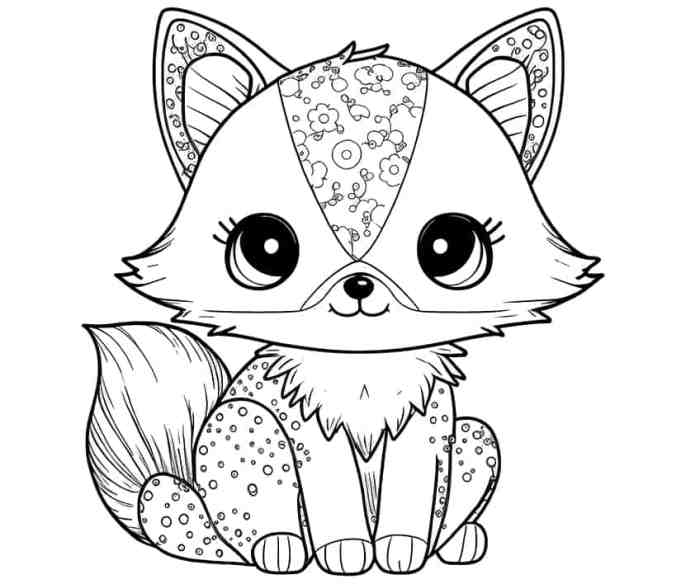Illustrative Techniques and Styles: Aesthetically Animal Coloring Page

Aesthetically animal coloring page – The aesthetic impact of an animal coloring page is profoundly shaped by the chosen illustrative technique. The style directly influences the final mood, complexity, and overall visual appeal, guiding the coloring experience for the user. A delicate pencil sketch evokes a different feeling than a bold watercolor wash, and digital painting offers yet another unique aesthetic. Understanding these nuances is key to creating truly captivating coloring pages.
Illustrative Technique Effects on Aesthetics
The choice of illustrative technique significantly alters the final look and feel of an animal coloring page. Watercolor, for instance, lends itself to soft, fluid lines and a sense of ethereal beauty. The transparency and blending capabilities create a dreamlike quality, perfect for depicting animals in natural settings or showcasing delicate features like feathers or fur. Pencil sketches, on the other hand, offer a more intimate and detailed approach.
The varying pressure and line weight create texture and depth, allowing for intricate details and expressive rendering of animal anatomy. Digital painting offers the most versatility, combining the precision of pencil work with the fluidity of watercolor and the ability to add textures and effects not easily achievable with traditional media. This allows for a wide range of styles, from photorealistic depictions to stylized, almost cartoonish interpretations.
Consider a majestic lion rendered in watercolor – the soft washes would capture the animal’s mane beautifully, while a digital painting might allow for more vibrant colors and sharper details in its muscular frame. A pencil sketch, in contrast, could focus on the subtle textures of its fur and the intensity in its gaze.
Positive and Negative Space in Animal Designs
The balance between positive (the animal itself) and negative (the surrounding space) space is crucial for creating aesthetically pleasing designs. Effective use of both enhances the overall composition and visual impact.
- Positive Space Strengths: Detailed animal illustrations with a strong focus on anatomy and features. The animal is the clear focal point, drawing the eye immediately.
- Positive Space Weaknesses: Overly detailed positive space can feel cluttered and overwhelming, particularly in smaller formats. It can also overshadow the overall design and reduce the visual impact of the negative space.
- Negative Space Strengths: Creates a sense of openness and allows the animal form to breathe. It can enhance the animal’s silhouette and emphasize its shape. Effective negative space can make even simple designs visually striking.
- Negative Space Weaknesses: Too much negative space can make the animal appear lost or insignificant within the design. The lack of detail in the negative space might lead to a lack of visual interest if not carefully managed.
A well-balanced design uses both positive and negative space effectively. For example, a simple silhouette of a bird against a sunset (extensive negative space) can be just as impactful as a detailed portrait of a cat (extensive positive space), depending on the desired aesthetic.
Texture and Pattern in Enhancing Visual Appeal, Aesthetically animal coloring page
Texture and pattern play a vital role in adding depth, visual interest, and realism to animal coloring pages. They can transform a flat image into a dynamic and engaging piece.
- Texture: Adding texture simulates the feel of the animal’s fur, scales, or feathers. This can be achieved through various techniques like stippling, hatching, cross-hatching, or using varied line weights in pencil sketches or digitally adding texture maps. For example, a tiger’s stripes can be enhanced with short, sharp strokes to suggest a rough, bristly texture, whereas a seal’s smooth fur can be indicated by subtle shading and blended lines.
- Pattern: Patterns are particularly effective in creating visually appealing designs. Repeating patterns in an animal’s coat, wings, or scales add visual rhythm and interest. These can be incorporated organically, reflecting natural patterns found in animals (like spots on a leopard), or creatively designed to add a stylistic touch. A simple repeating geometric pattern can add visual complexity without overwhelming the animal’s form.
The combination of texture and pattern can significantly enhance the overall aesthetic appeal. For instance, a peacock’s feathers, rendered with detailed patterns and textural variations, will appear far more realistic and visually engaging than a flat representation of its plumage.
I’ve been obsessed with aesthetically pleasing animal coloring pages lately, focusing on intricate details and vibrant color palettes. To expand my collection, I recently discovered a fantastic resource for wild animal coloring pages printable , offering a huge variety of designs. Finding those printable pages really helped elevate my artistic exploration of aesthetically pleasing animal coloring pages; now I have even more options to choose from!
